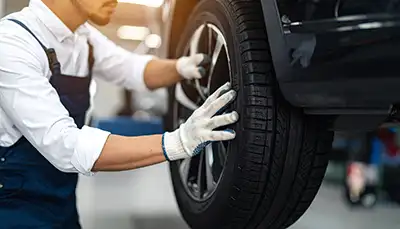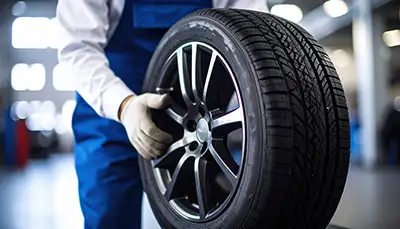Essential Tire Maintenance for Performance & Longevity
Your tires are the only point of contact between your vehicle and the road, making them crucial for safety, performance, and fuel efficiency. Proper tire maintenance not only extends the life of your tires but also enhances vehicle handling, improves fuel economy, and ensures optimal safety in all driving conditions. This comprehensive guide covers everything you need to know about keeping your tires in peak condition.
Tire Pressure Maintenance
Maintaining proper tire pressure is the single most important aspect of tire care. Incorrect inflation affects everything from fuel economy to handling and tire longevity.
Finding the Correct Pressure
The recommended tire pressure for your vehicle can be found in several locations:
- Driver's side door jamb sticker
- Vehicle owner's manual
- Inside the glove compartment or fuel door
Note that the pressure listed on the tire sidewall is the maximum pressure the tire can hold, not the recommended pressure for your vehicle.
Proper Inflation Techniques
- Check pressure when cold: Measure tire pressure when tires haven't been driven on for at least three hours. Driving heats up tires and increases pressure readings.
- Monthly checks: Inspect tire pressure at least once a month and before long trips.
- Seasonal adjustments: Tire pressure typically drops 1 PSI for every 10°F decrease in temperature. Adjust accordingly during seasonal changes.
- Don't forget the spare: Include your spare tire in regular pressure checks.
Consequences of Improper Inflation
- Underinflation: Causes excessive flexing, heat buildup, increased rolling resistance, premature wear on outer edges, and reduced fuel economy. Severe underinflation can lead to tire failure.
- Overinflation: Results in a harsher ride, uneven center tread wear, reduced traction, and increased vulnerability to impact damage.
Tire Rotation
Regular tire rotation helps ensure even tread wear, extending tire life and maintaining consistent handling and performance.
Rotation Intervals
Most manufacturers recommend rotating tires every 5,000-7,000 miles or according to your vehicle's maintenance schedule. If you notice uneven wear, you may need more frequent rotations.

Rotation Patterns
The correct rotation pattern depends on your vehicle's drivetrain and tire type:
- Front-wheel drive: Move front tires to the rear in the same left/right position, and move rear tires to the front while crossing them (left rear to right front, right rear to left front).
- Rear-wheel drive: Move rear tires to the front in the same left/right position, and move front tires to the rear while crossing them (left front to right rear, right front to left rear).
- All-wheel drive: Typically follows the same pattern as front-wheel drive vehicles.
- Directional tires: Can only be rotated front to back on the same side due to their directional tread pattern.
- Different sized tires: Vehicles with staggered setups (different sized front and rear tires) can only be rotated side to side.
Wheel Alignment & Balancing
Proper alignment and balancing are essential for even tire wear and optimal handling.
Wheel Alignment
Alignment refers to the adjustment of your vehicle's suspension components to ensure proper angles between the tires and the road.
- When to check alignment:
- Every 15,000-30,000 miles or as recommended in your owner's manual
- After hitting significant potholes or curbs
- When installing new tires
- If you notice uneven tire wear or your vehicle pulling to one side
- Alignment angles:
- Camber: The inward or outward tilt of the tire when viewed from the front
- Caster: The angle of the steering axis when viewed from the side
- Toe: The direction the tires point relative to the vehicle's centerline
Wheel Balancing
Balancing ensures that weight is evenly distributed around the wheel and tire assembly.
- When to balance wheels:
- When installing new tires
- After repairing a tire
- If you feel vibration at certain speeds
- During tire rotation (recommended but not always necessary)
- Signs of imbalance: Vibration that typically occurs at specific speeds (often between 50-70 mph) and may be felt in the steering wheel, seat, or floorboard.
Tread Inspection & Wear
Regular tread inspection helps identify issues before they become safety hazards.
Checking Tread Depth
- Penny test: Insert a penny into the tread groove with Lincoln's head upside down. If you can see all of Lincoln's head, the tread depth is less than 2/32" and the tire should be replaced.
- Tread wear indicators: Most tires have built-in wear bars that appear as solid bands across the tread when worn to 2/32".
- Tread depth gauge: The most accurate method, providing precise measurements in 32nds of an inch.
While 2/32" is the legal minimum in most states, consider replacing tires when they reach 4/32" for better wet traction.
Identifying Irregular Wear Patterns
- Center wear: Often caused by overinflation
- Edge wear: Typically results from underinflation
- One-sided wear: Usually indicates alignment issues
- Cupping or scalloping: Can be caused by worn suspension components or balance issues
- Feathering: Often related to toe alignment problems
Seasonal Tire Care
Different seasons present unique challenges for tire maintenance.
Winter Tire Care
- Check pressure more frequently as temperatures drop
- Ensure adequate tread depth for snow traction (minimum 5/32" recommended)
- Consider dedicated winter tires in regions with sustained temperatures below 45°F
- Clean tires regularly to remove road salt that can damage rubber over time
Summer Tire Care
- Be cautious of pressure increases during hot weather
- Check for UV damage and cracking, especially on older tires
- Inspect for punctures more frequently if driving on construction routes
- Wash away road tar buildup that's more common in summer

Additional Maintenance Considerations
Tire Age
Even with adequate tread, tires degrade over time due to environmental factors. Most manufacturers recommend replacing tires that are 6-10 years old, regardless of tread depth. You can determine your tire's age by checking the DOT code on the sidewall—the last four digits indicate the week and year of manufacture (e.g., 3620 means the 36th week of 2020).
Valve Stem Maintenance
Valve stems can deteriorate or leak over time. Have them inspected during routine tire service, and consider replacing them when installing new tires. Always use valve stem caps to keep out debris and help maintain air pressure.
Tire Storage
If storing tires (such as seasonal sets):
- Clean tires thoroughly before storage
- Store in a cool, dry location away from direct sunlight, heat sources, and ozone-producing equipment
- Store mounted tires stacked horizontally or hanging on hooks
- Store unmounted tires standing upright, rotating position occasionally
Emergency Repairs
Temporary tire repair kits or sealants should only be used in emergency situations. After using such products, have the tire professionally inspected as soon as possible. Remember that not all punctures can be properly repaired—damage to sidewalls or large punctures typically require tire replacement.
Key Takeaways: Tire Maintenance
- Check tire pressure monthly using a quality gauge when tires are cold
- Rotate tires every 5,000-7,000 miles following the pattern appropriate for your vehicle
- Inspect tread depth regularly and replace tires when they reach 4/32" for safety
- Have alignment checked annually or after hitting significant obstacles
- Balance wheels when installing new tires or if you feel vibration at certain speeds
- Pay attention to irregular wear patterns as they indicate specific maintenance issues
- Replace tires that are more than 6-10 years old, even with adequate tread
FAQ: Tire Maintenance
How often should I check my tire pressure?
You should check your tire pressure at least once a month and before any long trips. Seasonal temperature changes can significantly affect pressure, so be especially vigilant during fall and spring when temperatures fluctuate most. Always check pressure when tires are cold (haven't been driven on for at least three hours) for the most accurate reading.
Is it better to slightly overinflate or underinflate my tires?
Neither is ideal. Always aim for the manufacturer's recommended pressure as specified in your owner's manual or door jamb sticker. If you must err slightly, a few PSI over is generally less dangerous than underinflation, which can lead to heat buildup and potential tire failure. However, overinflation reduces traction and ride comfort while making tires more susceptible to impact damage.
How can I tell if my tires need to be balanced?
The most common sign of imbalanced tires is vibration that occurs at specific speeds, typically between 50-70 mph. Depending on which tire is imbalanced, you might feel this vibration in the steering wheel (front tires) or through the seat/floor (rear tires). If the vibration changes with speed—intensifying as you go faster and diminishing at lower or higher speeds—imbalance is likely the cause.
Can I rotate my tires myself?
Yes, if you have the proper equipment (jack, jack stands, torque wrench) and experience. However, professional rotation ensures proper torque specifications and provides an opportunity for experts to inspect your tires and suspension components. Many shops offer free rotation for tires purchased there, making professional service both economical and thorough.
How do temperature changes affect my tire pressure?
Tire pressure typically changes by about 1 PSI for every 10°F change in temperature. Cold weather causes pressure to decrease, while warm weather causes it to increase. This is why you might find your tire pressure warning light illuminating during the first cold snap in fall. Always adjust pressure according to manufacturer specifications rather than adding a specific amount of air.
What's the difference between alignment and balancing?
Alignment adjusts the angles of your vehicle's suspension to ensure tires contact the road properly, affecting handling, tire wear, and vehicle tracking. Balancing ensures weight is distributed evenly around each tire/wheel assembly to prevent vibration and uneven wear. Both services are important but address different aspects of tire performance and wear. Typically, alignment is needed less frequently than balancing.